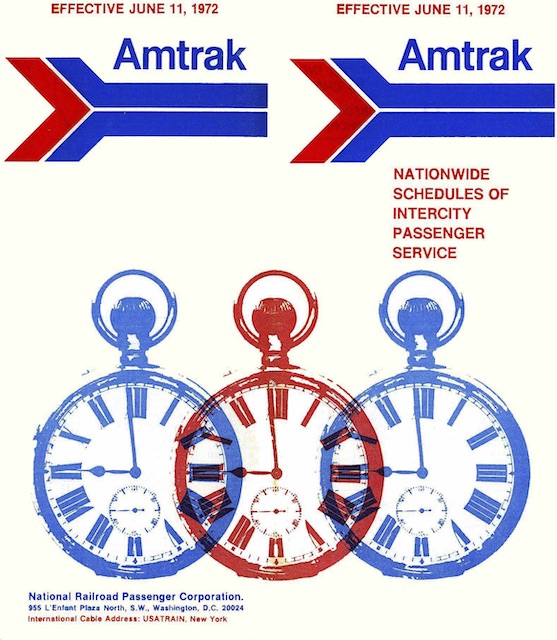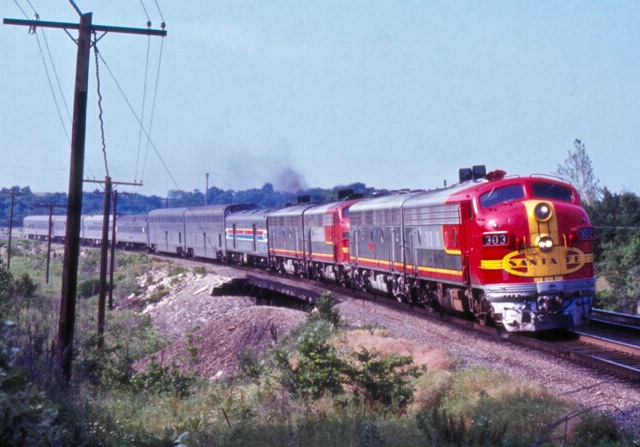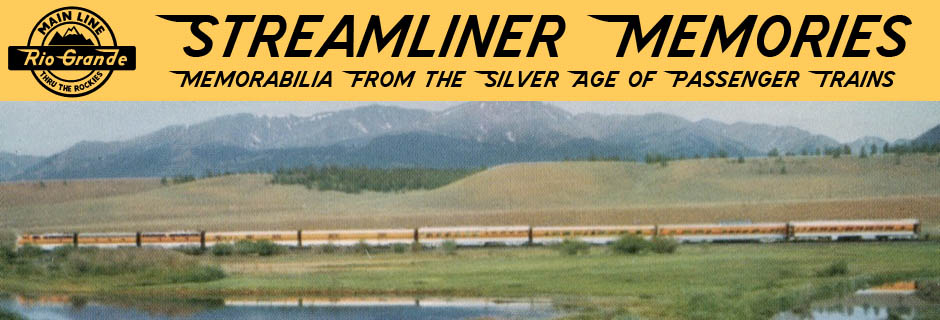Most of Amtrak’s overnight routes see just one train a day in each direction, and when I’ve tried to figure out how to make Amtrak work better I’ve sometimes thought they should run two trains a day on some of these routes. Two trains a day would allow every town on the route to have daytime service. Doubling frequencies might also have a synergistic effect, leading ridership to increase by more than double if people know they have more options.
 Click image to download a 15.0-MB PDF of this 60-page timetable.
Click image to download a 15.0-MB PDF of this 60-page timetable.
I recently learned that Amtrak actually tried this on Santa Fe’s Chicago-Los Angeles route in 1972. As recently as 1968, Santa Fe ran three trains on this route: the Super Chief/El Capitan (two trains operated on identical timetables), Chief, and Grand Canyon. Someone at Amtrak got the idea that it should try running two a day: the Super Chief/El Capitan, which left Chicago in the evening, and the Chief, which left Chicago in the morning.
The city that most benefitted from the Chief‘s schedule was Kansas City. The Super Chief/El Capitan passed through at 2:00 am westbound and 5:35 am eastbound, but the Chief served the city at the much-more decent hours of 5:00 pm westbound and 11:20 pm eastbound.

Led by warbonnetted Santa Fe locomotives, Amtrak’s first westbound Chief heads out of Kansas City on June 11, 1972. The baggage car, two hi-level coaches, and trailing sleeping car are all Santa Fe heritage, but the dining car following the second high-level coach is not and the second-to-last car is a slumbercoach, none of which were owned by Santa Fe. It is likely that the slumbercoach and the car in front of it, which may be an ex-Santa Fe 44-seat coach, were picked up from the National Limited in Kansas City. Photo by Bill Keene © 1972, who also kindly provided much of the historic information in this post.
Amtrak may also have been inspired by a desire to run through cars from coast to coast. The passenger railroad then had a New York-Kansas City train called the National Limited. As advertised on page 58 of this timetable, assuming the National was on time (something that was never certain in Amtrak’s early years), westbound passengers could connect with the Chief with just a 35-minute layover.
The Chief didn’t help eastbound passengers as the National left Kansas City at 9:40 am, so passengers arriving on the Super Chief/El Capitan had 7 hour 40 minute early-morning layover. Nevertheless, Amtrak tried running both a coach and a sleeping car through between Los Angeles and New York. After the Chief stopped running, Amtrak still ran a through sleeping car (with a much-longer westbound layover in Kansas City) but not a coach.
The Chief was apparently meant to be a summer-only experiment, as this timetable states that the Chief‘s last trip would be September 22. Amtrak didn’t repeat the experiment in 1973, probably because the synergistic effects weren’t there and ridership was lower than expected.
The timetable pictured above isn’t from my collection. Instead, I downloaded and combined into a PDF individual pages from the Museum of Railway Timetables which, despite the name, is focused on Amtrak timetables. Incidentally, the cover picture shown above is actually the back cover, a bad habit that Amtrak followed in its first few years. The front cover was an ad featuring artwork by Charles Saxon, who was best known as a New Yorker cartoonist.

It is also thought that when the private railroads were trying to reduce their passenger deficits, they found that taking off secondary trains had the effect of apportioning all costs, both direct and indirect, to the remaining train on each route making its financial performance appear even more dismal. Don’t know if that accounting method applies to Amtrak or not.